Gwyddelwern is a village situated on the banks of the River Dee, to the north of the town of Corwen. The village was in the historic Merionethshire up until 1974 when it became part of Clwyd, but in 1996 became part of Denbighshire. The men of Gwyddelwern who fell during both World Wars are commemorated on the village war memorial, which is located in the grounds of the Wesleyan Chapel. As Gwyddelwern was within Merionethshire at the time of both wars, this page is under the Merionethshire section of the website.
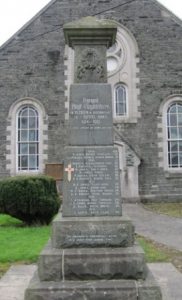
The Great War, 1914-1918
Thomas David Atkinson, Private, 3520, Welsh Guards. Thomas was the son of John and Ann Atkinson, of Angharad, Corwen. He married Hannah Read in 1911. Thomas worked as a farm labourer at Gwyddelwern, and applied at the Corwen military tribunal for an exemption from military service in 1916, due to being a farm worker. His appeal was initially successful, but in October 1916 Thomas enlisted at Wrexham into the Welsh Guards. After completing his training, he was posted to France at some time in 1917, joining the 1st Battalion, Welsh Guards. The battalion had been in France since 1915 attached to the Guards Division, and Thomas probably joined up with the battalion at Ypres, following its successful assault on the Pilckem Ridge on 31 July 1917. The Guards made another large scale attack on 10 October, towards the Houthulst Forest, at the northern edge of the salient, and in November moved south to take part in the Battle of Cambrai. The Guards moved into the battle area near Flesquières and supported the assault on Bourlon Wood, but then became caught in in heavy fighting when the Germans counter-attacked. After the battle died down, the Guards wintered in the Arras area and on 6 March 1918 moved back into the front line at Rouex, for another short rotation in the trenches. On the night of 10 March the Welsh Guards launched a successful trench raid against the Germans opposite them, and on the following day, 11 March 1918, the Germans launched a retaliatory trench mortar barrage on the Welsh Guards lines. Thomas was killed during the barrage that day. He was 24-years-old and is buried in Level Crossing Cemetery, Fampoux, France.
Hugh Edward Davies, Private, 266955, Welsh Regiment. Hugh was the son of Robert Ellis Davies and Mary Davies, of Fron Beuno, Gwyddelwern. He enlisted at Denbigh into the Royal Welsh Fusiliers, but after being drafted to France in 1916 was posted to the 1/6th Battalion, Welsh Regiment. The battalion had been raised in Swansea and was attached to the 1st Division, as the Divisional Pioneers. At some time after, Hugh was transferred to the 13th Battalion, Welsh Regiment, which was attached to 114 Brigade, 38th (Welsh) Division. He probably joined the battalion at Ypres, where the Division had taken over the Canal Bank sector north of the city. It remained here for several months, until launching its successful offensive on the Pilckem Ridge on 31 July 1917. The Division then consolidated its gains along the Steenbeek whilst the British readied for the next phase of the offensive, towards Langemarck. On 21 August 1917 the 13th Welsh moved forwards from Alouette Farm and relieved the 10th Welsh in the front line at the Steenbeek. Soon afterwards a German artillery barrage came down onto their positions, killing Hugh and five other men, and wounding several others. Hugh, who was 22 years old, was originally buried by the Divisional Chaplain nearby, but his grave was lost following further fighting, and he is commemorated on the Tyne Cot Memorial, Belgium.
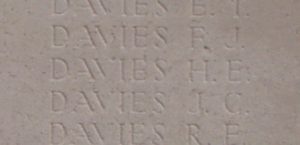
Price Davies, Rifleman, S/7917, Rifle Brigade. Price was the son of Robert Abram and Charlotte Davies, of Bryn Celyn, Bryn Saith Marchog, Corwen. He worked as a steelworker prior to enlisting at Wrexham into the Rifle Brigade on 12 January 1915. Price was posted to the 11th Battalion, Rifle Brigade, which embarked for France on 21 July 1915, attached to 59 Brigade, 20th (Light) Division. The Division moved to the Fleurbaix Sector for trench familiarisation and training. When the Battle of Loos was launched on 25 September 1915 the Division fought a diversionary attack towards Fromelles. Later that year it moved north, and fought at the Battle of Mount Sorrel alongside the Canadian Corps, before moving south again, to the Somme sector in August. Price’s battalion moved into the Somme trenches for the first time on 22 August, taking over a section near Montauban. The battalion suffered a German counter-attack and several artillery bombardments in the coming days, until it was relieved on 28 August, and started preparations for an assault. At 12.00 on 3 September 1916 the preliminary artillery barrage opened up and half an hour later the 11th Rifle Brigade launched its attack at Guillemont, and during a day of terrible fighting cleared the Germans off the ridge by Leuze Wood. Price was one of many casualties suffered by the battalion that day, being killed in action during the assault. The 27-year-old has no known grave and is commemorated on the Thiepval Memorial, France.
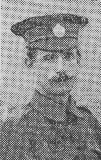
David Ellis, Private, 30453, Royal Welsh Fusiliers. David was the son of Hugh and Jane Ellis, of Bryn Brith, Gwyddelwern. He was a well known vocalist, who had performed in several Eisteddfod’s prior to the war. He enlisted at Llanfair, Anglesey into the Montgomeryshire Yeomanry on 17 September 1914, and after two years on home service with the Yeomanry, embarked at Devonport for Salonika on 20 September 1916. Upon arrival in Salonika, David was posted to the 11th Battalion, Royal Welsh Fusiliers, which was attached to 67 Brigade, 22nd Division. The Division had been moved there in 1915 to support the Greek Army following the invasion of their homeland by Bulgarian troops. David took part in two large-scale battles during the following months. David was killed in action during a routine spell in the trenches on 10 June 1918, aged 24. He is buried in Karasouli Military Cemetery, Greece.
E. Jones. This man cannot presently be identified, but the memorial states that he died in 1917 aged 33, and lived at Hafod Las, Gwyddelwern. The occupiers of Hafod Las were Edward and Catherine Jones, and they had five sons, none with the initial E as their forename.
John Ogwen Jones, Private, 204092, Royal Welsh Fusiliers. John was the son of Mary Elizabeth Jones, of Bryngoleu, Gwyddelwern. He was employed as a farm servant at Caenog and Branas Ucha, Llandrillo prior to marrying Elizabeth Evans, of Bodowen, Llandrillo, in 1915. John enlisted at Dolgellau into the Royal Welsh Fusilers, and was posted to France in March 1918, joining the 15th Battalion, Royal Welsh Fusiliers, which was attached to 113 Brigade, 38th (Welsh) Division. He was then transferred to the 9th Battalion, Royal Welsh Fusiliers, which was attached to 58 Brigade, 19th (Western) Division. The Division had taken a battering when it became caught up in the German Spring Offensive on the Somme from 21 March, and John was probably transferred to it from the 38th Division as it was rebuilding in the Messines area. The Division was unfortunately caught up in heavy fighting again when the Germans launched the second phase of their Spring Offensive along the Lys valley on 9 April, and over the coming days saw terrible fighting. John was killed in action whilst attached to the 58th Light Trench Mortar Battery on 9 May 1918, when the battery came under fire from German artillery. He was 34 years old and is buried in La Brique Military Cemetery No.2, Belgium.
Robert Jones, Private, 25088, Royal Welsh Fusiliers. Robert was the son of Edward and Alice Jones, of The Forge, Bryn Saith Marchog. He enlisted at Corwen into the 17th Battalion, Royal Welsh Fusiliers on 1 February 1915. He joined the battalion at Llandudno, where it was attached to the 38th (Welsh) Division, but when the Division moved to Winchester to complete his training, Robert was among a number of men who remained behind, being reserve troops for the Division. On 15 October 1915 he was posted to Gallipoli to join the 8th Battalion, Royal Welsh Fusiliers, which was attached to 40 Brigade, 13th (Western) Division. The Division had suffered heavy casualties during several failed offensives, and was at Suvla Bay when Robert arrived. Just prior to the evacuation of the Peninsula, Robert was struck in the head by a piece of shrapnel which took off part of his skull, and was taken aboard the Hospital Ship Devonta, which carried him to hospital in Malta. He died of his wounds there on 23 January 1916, aged 22, and was buried in Pieta Military Cemetery, Malta.
Robert Pierce Jones, Private, 3/59064, Cheshire Regiment. Robert was the son of Isaac and Grace Jones, of Tyn-y-Cefn, Corwen. He married Nellie Edwards at Corwen in 1912, and the couple lived at Berwyn Terrace, Corwen. Robert worked as the Queensferry Munition Works prior to enlisting into the Royal Field Artillery in October 1916. In January 1917 he was transferred to the 3rd Battalion, Cheshire Regiment, and was posted to France soon afterwards, joining the 13th Battalion, Cheshire Regiment, which was attached to 74 Brigade, 25th Division. The Division was in the Ploegsteert area when Robert joined its ranks, holding the line to the east of Ploegsteert Wood, and alternated between this sector and Le Touquet over the coming weeks. Robert was seriously wounded in the right leg during one such tour of the trenches in April 1917. He was evacuated to No 2 Casualty Clearing Station, Bailleul where he died of his wounds on 29 April 1917, after having his leg amputated. He was 26 years old and was buried in Bailleul Communal Cemetery Extension, France.
William Jones, Private, 17980, Royal Welsh Fusiliers. William was the son of Thomas and Elizabeth Jones, of Derwen Corwen. He worked as Tan y Bryn, Gwyddelwern prior to the war. William enlisted at Corwen into the 16th Battalion, Royal Welsh Fusiliers soon after the outbreak of war. The battalion was raised at Llandudno by the Welsh National Executive Committee from a cadre from the 13th Battalion, joining 128 Brigade, 43rd (Welsh) Division and trained in North Wales before moving to Winchester in the summer of 1915, where the formation became renumbered 113 Brigade, 38th (Welsh) Division. The Division moved to France on 2 December 1915 and moved to the Nursery Sector near Fleurbaix for trench initiation alongside the Guards Division. The Division then held a sector of the line near Cuinchy before marching south to the Somme sector in June 1916 to take part in the assault on Mametz Wood. The first attack on the wood was launched on a two-battalion front on 7 July, but failed, and the Divisional Commander, Sir Ivor Philipps, was replaced before the Division attacked again on a two Brigade front on 10 July 1916. William was killed in action on the following day, 11 July 1916, aged 23. He has no known grave and is commemorated on the Thiepval Memorial, France.
Oliver Bowyer Leah, Sergeant, 16893, The Loyal North Lancashire Regiment. Oliver was the son of Thomas Allen Leah and Sarah Jane Leah (nee Bowyer), of Berwyn House, George Street, Alderley Edge. His mother was from Gwyddelwern, and Oliver was well known in the village, spending many holidays with his grandmother at Elwern Villa. He enlisted into the Loyal North Lancashire Regiment at Bolton in September 1914, and was posted to the 8th Battalion, Loyal North Lancashire Regiment, which was attached to 74 Brigade, 25th Division. After completing its training, the Division embarked for France, and Oliver landed with his battalion at Boulogne on 16 September 1915. The Division moved to the Vimy area, and got caught up in heavy fighting during a German attack on the Broadmarsh Crater, east of St. Eloi in May 1916. The Division then moved south to the rear of Arras at the end of May and trained at Monchy Breton before beginning its move to the Somme on 14 June. By 3 July the Division was at Aveluy Wood, and during the evening relieved another division in the trenches. Oliver’s battalion was in reserve at Crucifix Corner, and on the evening of 7 July moved into the line by the Leipzig Salient, in front of Aveluy. The battalion moved again on the night of 9 July, into the newly gained German line near Ovillers and La Boiselle. At 13.00 on 10 July Oliver’s battalion received their orders to attack, before leaving their trenches, and immediately came into contact with the Germans. Heavy fighting raged throughout the day, and through the night, and the battalion suffered terribly. Oliver had been killed in action at some time on 10 July 1916 during the attack. He is buried in Pozieres British Cemetery, Ovillers-La Boiselle, France. Although well-known locally, Oliver is not commemorated on the Gwyddelwern memorial.
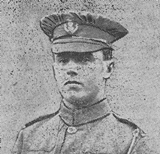
Robert Lewis, Private, 2564, Royal Welsh Fusiliers. Robert was the son of Evan and Jane Lewis, of Beuno Terrace, Gwyddelwern. He enlisted at Corwen into the 7th Battalion, Royal Welsh Fusiliers. The battalion was a Territorial unit, which mobilised for war at Newtown in August 1914, as part of North Wales Brigade, Welsh Division and moved to Conway until the end of the month, before moving to Northampton. In December the Division moved to Cambridge and then in May 1915 to Bedford, where the Division was numbered and the formation became 158 Brigade, 53rd (Welsh) Division. On 19 July 1915 the entire Division sailed from Devonport for Imbros and on 9 August 1915 landed at Suvla Bay. The infantry moved off the beaches into the bush, but due to a lack of maps and no knowledge of the terrain, many of the units became disorientated, and the situation became chaotic. The Division remained at Gallipoli after the coming months, in terrible conditions which saw more men taken ill than wounded. The 7th RWF were moving back from a short rest into reserve trenches on 8 November 1915, when Robert was killed by a Turkish sniper. The 21-year-old has no known grave and is commemorated on the Helles Memorial, Gallipoli.
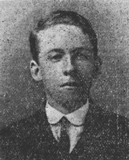
Edward Lloyd, Private, 46953, King’s Own Scottish Borderers. Edward was the son of Amelia Lloyd, of Brynllan, Gwyddelwern. He became a grocers apprentice at Chirk after leaving school, then took up a position at Seymours and Meads, in Manchester by 1911. In 1912 he married Edith Mabel Allin, and the couple lived in 214, Horton Road, Rusholme, Manchester. Edward enlisted into the army in 1916 and was posted to the 10th Battalion, King’s Own Scottish Borderers. The battalion was formed in 1918 and joined 120 Brigade, 40th (Bantam) Division. After the Armistice, he was posted to Ireland, before being transferred to Dunfermline, but his health began to break down, and he was found to be a diabetic. Edward died in a diabetic coma at Dunfermline on 27 March 1919, aged 34. His remains were conveyed home and he was buried in Manchester Southern Cemetery.
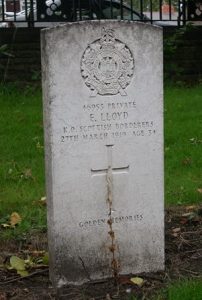
James John Arthur Phillips, Sergeant, 679, Royal Warwickshire Regiment. James was born at Aberdaron on 3 June 1884, the son of James and Catherine Phillips. By 1891 the family was living at the School House, Gwyddelwern, where his father had become Schoolmaster. James followed in his father’s profession, and worked as a teacher at Daisybank Council School, Coseley prior to the war. He enlisted at Birmingham into the 16th Battalion, Royal Warwickshire Regiment. The battalion was raised at Birmingham by the Lord Mayor, before moving to Wensleydale in June 1915, joining 95 Brigade, 32nd Division. During August 1915 the Division moved to Codford, Salisbury Plain. James’s qualities as a soldier shone during his training, and by now he had been promoted to Sergeant in the 12th Platoon, after excelling in musketry, and became an instructor to the battalion. Unfortunately, his health deteriorated, due to becoming diabetic, and James was treated at Codford St. Mary Hospital before being sent home on sick leave. A week after arriving home, James fell into a diabetic coma, and died on 14 November 1915, aged 31. He was buried with full military honours in St. Beuno’s Churchyard, Gwyddelwern.
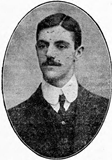
David Roberts, Private, 37093, Royal Welsh Fusiliers. David was the son of Ellis and Jane Roberts, of Maesgamedd Isa, Gwyddelwern. He worked as a slater and plasterer prior to enlisting at Oswestry into the Royal Welsh Fusiliers at Oswestry on 20 November 1915 and was posted to the Depot at Wrexham, joining the 3rd Battalion, Royal Welsh Fusiliers. On 26 April 1916 David embarked at Southampton aboard the SS Copenhagen, and disembarked in Rouen, joining No 2 Infantry Base Depot. On 31 May 1916 David joined the 2nd Battalion, Royal Welsh Fusiliers, which was in the line at Auchy, attached to 19 Brigade, 33rd Division. The battalion was carrying out the normal routine of trench rotation at the time, and on 4 June moved to billets at Annequin South, then to Bethune a week later. On 20 June the battalion relieved the 4th Suffolks in the Givenchy Left sector of the front, to begin another tour in the trenches. At 02.50 on the morning of 22 June 1916 a massive mine exploded under B Company’s positions on the right of Givenchy Left, destroying 80 yards of line, and was followed by an intensive artillery bombardment which preceded a large-scale trench raid by around 150 Germans. The 2nd RWF fought desperately, but suffered terrible casualties throughout the morning. David was among over fifty men killed during the day, during the fighting at what was later named Red Dragon Crater. He was 20 years old, and is buried in Gorre British and Indian Cemetery, Pas de Calais, France.
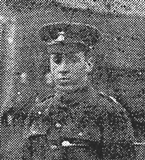
Evan Roberts, Private, 37092, Royal Welsh Fusiliers. Evan was the son of Ellis and Ellen Roberts, of Elim Cottage, Wern, Llanrhaiadr. He worked as a farm labourer for Ernest Hughes, at Wernddu, Gwyddelwern prior to enlisting at Oswestry into the Royal Welsh Fusiliers on 20 November 1915 and was posted to the Depot at Wrexham, joining the 3rd Battalion, Royal Welsh Fusiliers. On 26 April 1916 Evan embarked at Southampton aboard the SS Copenhagen, and disembarked in Rouen, joining No 2 Infantry Base Depot. On 7 May 1916 Evan joined the 2nd Battalion, Royal Welsh Fusiliers, which was in the line at Auchy, attached to 19 Brigade, 33rd Division. The battalion was carrying out the normal routine of trench rotation at the time, and on 4 June moved to billets at Annequin South, then to Bethune a week later. On 20 June the battalion relieved the 4th Suffolks in the Givenchy Left sector of the front, to begin another tour in the trenches. At 02.50 on the morning of 22 June 1916 a massive mine exploded under B Company’s positions on the right of Givenchy Left, destroying 80 yards of line, and was followed by an intensive artillery bombardment which preceded a large-scale trench raid by around 150 Germans. The 2nd RWF fought desperately, but suffered terrible casualties throughout the morning. Evan survived the carnage at Red Dragon Crater, as he was in hospital suffering from measles, but re-joined the battalion on 1 June, prior to its move south to the Somme on 9 July. A week later, the 2nd RWF began moving up to the front, marching into the ghostly ruins of Mametz Wood on 16 July, and two days later moved to Bazentin-le-Petit, to join the fighting for High Wood. The battalion attacked the wood from Flat Iron Copse on the morning of 20 July 1916, and managed to gain a foothold in the wood, despite suffering heavily. Evan was killed during the days fighting. The 24-year-old has no known grave and is commemorated on the Thiepval Memorial, France.
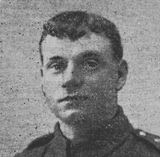
Robert Hugh Roberts, Private, 23313, Royal Fusiliers. Robert was the son of Robert Owen Roberts and Anne Jane Roberts, of Hendre Isa, Gwyddelwern. He lived at Colwyn Bay prior to the war and enlisted in the town into the Royal Fusiliers, and was posted to the 7th Battalion, Royal Fusiliers. The battalion landed at Le Havre on 24 July 1916, and moved to Vendrel, where it spent next few weeks carrying out intensive training. The battalion then joined 190 Brigade, 63rd (Royal Naval) Division, which was in the Souchez sector. The Division had moved to France in May 1916, following service in Gallipoli, and spent time in the Souchez then the Calonne sectors before moving to positions on the Somme during the first week of October 1916. At midday on 8 October, the 7th Royal Fusiliers marched through Mailly Maillet towards the front, taking up positions near Redan Ridge, to begin its first tour in the Somme sector. On 7 November the battalion paraded at Hedauville, before beginning preparations for a raid on Mound Trench, which was carried out successfully during the night. The battalion then had a brief rest before moving back into the front line at Hamel on 12 November. On the following morning, 13 November 1916, the British launched the Battle of the Ancre, and the 63rd Division was in the centre of the attack. The 7th Royal Fusiliers suffered terribly during the days fighting, losing almost 400 killed, wounded or missing. Robert was among the men killed during the day. He was 22 years old and is buried in Ancre British Cemetery, Beaumont Hamel, France.
William Frederick Weeks, Private, 25487, South Wales Borderers. William was born at Rhuddlan, the son of Oliver and Mary Weeks. Prior to the war the family had moved to the Station House, Gwyddelwern. William followed in his father’s footsteps, joining the LNWR at Rhyl and became a stationmaster himself at Pentraeth, Anglesey prior to the war. He enlisted at Bangor into the King’s Shropshire Light Infantry in March 1916, but was later transferred to the 11th Battalion, South Wales Borderers. He joined the battalion at Ypres, where it had moved to as part of 115 Brigade, 38th (Welsh) Division, following its efforts during the capture of Mametz Wood. The Division took over the Canal Bank sector to the north of Ypres, where it remained for almost a year before launching its offensive on the Pilckem Ridge on 31 July 1917. The Division attacked on a two-brigade front from its positions east of the canal and once their objectives had been gained, 115 Brigade moved forward to support the two attacking Brigades, and launched their attack on the Steenbeek from the direction of Iron Cross. William was killed in action during this phase of the battle that day. He was 24 years old and is buried in Birr Cross Roads Cemetery, Ypres.
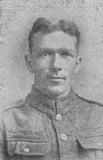
World War Two, 1939-1945
Griffith John Hughes, Fusilier, 4199000, Royal Welch Fusiliers. Griffith was the son of John and Jane Hughes, of Ivy House, Gwyddelwern. He enlisted into the 6th Battalion, Royal Welch Fusiliers. The battalion was attached to 158 Brigade, 53rd (Welsh) Division, and spent much of the war on home service, in Northern Ireland and the south of England, before embarking for Normandy towards the end of June 1944. The Division was then moved forwards to the front, to take part in the break-out, seeing terrible fighting in the Bocage. 158 Brigade took part in its first major action during an assault on the German held village of Evrecy on 15 July, and got caught up in fierce fighting when it was counter-attacked German infantry supported by tanks of the SS Panzer Division Hohenstaufen. Griffith died in Normandy on 23 July 1944, possibly of injuries suffered during the fighting for Evrecy. He was 26 years old and is buried in Ryes War Cemetery, Bazenville, France.
Eric Williams, Boy 1st Class, D/SSX 28051, Royal Navy. Eric was born at Glan Afon, Gwyddelwern on 29 September 1921, the son of Thomas Williams and Margaret Williams. The family later resided at Prestatyn. He enlisted into the Royal Navy and was posted aboard the aircraft carrier, HMS Courageous. She was a converted Great War era cruiser, and became a training carrier prior to the outbreak of World War Two. With war looming, Courageous was returned to service, and moved to her war station at Portland, where she took aboard two squadrons of Fairey Swordfish. Courageous left Plymouth on the evening of 3 September 1939 for an anti-submarine patrol in the Western Approaches, escorted by four destroyers. On the evening of 17 September 1939, she was on patrol off the coast of Ireland, and was unwittingly being stalked by the German submarine U-29. As Courageous started to turn to launch some of her aircraft, the submarine fire three torpedoes at her, and the carrier capsized and sank in 20 minutes with the loss of 519 of her crew. Eric was just 17 years old when he was killed in the sinking that day. He has no known grave and is commemorated on the Plymouth Naval Memorial, Devon. His brother, Robert Gwilym Williams, also died on service.
Robert Gwilym Williams, Able Seaman, D/JX 417782, Royal Navy. Robert was born at Glan Afon, Gwyddelwern on 2 April 1925. He enlisted into the Royal Navy following the outbreak of war and was posted aboard the Bangor class Minesweeper HMS Wedgeport. She had been built in Canada and completed her commissioning on 21 April 1942 before taking up anti-submarine duties around the coast of Scotland. Robert was ashore when he was injured in a road accident at Canvey Island. He died of his injuries on 9 April 1945, aged 20. His remains were conveyed home for burial in Coed Bell Cemetery, Prestatyn.